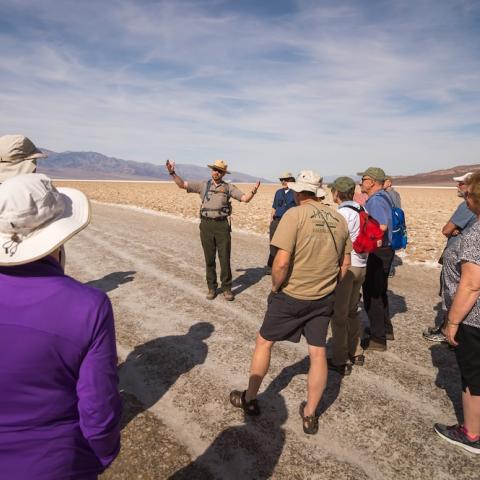
The Keane Wonder Mine in Death Valley National Park has reopened for visitors to explore...from a safe distance/NPS
With all the excitement of a birthday party, Death Valley National Park officials gave a rousing celebration to the reopening of the Keane Wonder Mine, long recognized as one of the best examples of historical gold mining in the park.
The mine was one of the most popular sites in the park prior to its closure, for safety reasons, in 2008. A visitor was killed at the Keane Wonder Mine in 1984 when he fell down an unprotected vertical shaft. To make the area safer for visitors, the park closed off entrances to mine openings and stabilized the tramway towers, upper terminal, and lower terminal.
Death Valley has an interesting mining history. It began with prospecting during the California Gold Rush era and included a good bit of mining during the late 1800s and early 1900s. Various mines in Death Valley extracted gold, silver, lead, zinc, antimony, flourspar, cinnabar, epsom salts, mercury, tungsten, copper, borax, talc, sodium chloride and manganese.
Death Valley’s most famous mining operation is the borax mining that commenced in the early 1870s and employed the famous twenty-mule team wagons at the Harmony Borax Works during the 1880s.
Few mining operations in Death Valley proved profitable. The technology employed was primitive and inefficient, water was scarce, fuel was expensive, and transportation facilities were lousy. Most metallic mining was over by 1910, and the last of the silver and gold mines in Death Valley were gone by about 1915. Some mining, most of it small scale, continued at sporadic intervals in subsequent decades.
The last significant mining in the park, a talc mining operation that commenced during the 1940s and was still active in the early 1980s, was terminated when an environmental NGO purchased the claims in 1989 and donated them to the park. No new mining claims have been permitted in Death Valley since Congress passed the Mining in the Parks Act in 1976. However, there are still many patented and unpatented mining claims on park property. These claims are diminishing in number as some are extinguished and others are acquired by the Park Service.
Mining operations have left the Death Valley landscape littered with abandoned mines and related debris that pose hazards to unwary or unlucky visitors. The National Parks Conservation Association estimates that there are at least 2,000 hazardous mine features in Death Valley. That’s about one-third of the dangerous mines in the entire National Park System.
Death Valley visitors have long been fascinated with the park’s abandoned mines. More than just interesting relics, old mines – especially gold mines -- are the visible remnants of a romantic era in American history. People like to wander around the mine sites, inspect the old equipment, poke among the debris, and take photographs. Perilous though it may be, some people even venture inside old mine shafts in accessible locations.
The Keane Wonder Mine, a gold mine that operated in the funeral Mountains from the early 1900s until 1942, was one of the two most productive gold mines in Death valley (the other being Skidoo). The Keane Wonder has been among the most attractive of Death Valley’s abandoned mine sites. The Park Service purchased the claim in 1970.
Here's a short video of the mine's reopening the other day.




 Support Essential Coverage of Essential Places
Support Essential Coverage of Essential Places






